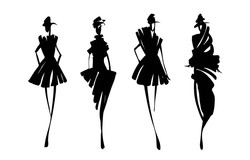Fashion from Three Continents
Global brands often seek inspiration from African, Middle Eastern and South American fashion trends with their extraordinarily vibrant visuals. On the other hand, designers from these regions face numerous challenges in trying to go global and remain on the international market. Speakers from Senegal, the United Arab Emirates and Brazil shared their views on the prospects for competition among local brands and big fashion conglomerates, and on other issues discussed with our magazine at the BRICS+ Fashion Summit.
What should leading fashion industry players do
right now to make international cooperation in this industry more effective?
Adama Amanda Ndiaye
Founder, Dakar Fashion Week and Adama Paris, Senegal
Attend events in other countries, network with foreign counterparts and study
creative work on different markets.
Alia Khan
Founder and Chairwoman, Islamic Fashion & Design Council, UAE
Most industry players struggle to understand consumer needs. To gain such
understanding, they need to study the culture, lifestyle and value system that
determine why a customer chooses certain things.
Olivia Merquior
Founder, Brazil Immersive Fashion Week, Brazil
We need to focus on a multifaceted approach that encourages collaboration and
leverages technology. Creating digital platforms for seamless communication and
resource sharing is essential. These platforms can host virtual showrooms,
supply chain management tools, and forums for cultural exchange. Developing
standardized practices across borders can help streamline operations, from
production to distribution.
What are the ongoing changes in terms of sustainability in the fashion
industry? What global trends do you see in this respect?
Adama Amanda Ndiaye
For me, the future of fashion is certainly built from within, involving
development of young and small brands and understanding their value. There is
no haute couture or anything like that in Africa. But there is an industry that
is advancing thanks to designers, be they young or older. By scaling their
brands, we are changing the industry as a whole.
We are moving towards sustainable development but there is still so much to do.
The key issue is finding suppliers, especially in African countries. We have
our own factories but the raw materials have to be imported and supply chains
are not transparent. A trend I like right now and we are currently joining is
recycling, reusing and upcycling.
Alia Khan
The best way to respect sustainability as a lifestyle is to buy less. So the
onus is on the consumer. To buy less – the first lesson in sustainability, and
not fall for hype and marketing strategies that don’t serve their interest.
Olivia Merquior
I am from Brazil, the country of the Amazon forest and of a great natural
environment. Daily in the news, I face serious infringements from large industries
from different parts of the world overexploiting native areas. Around the
world, we can see and feel the impact. The sustainability direction in the
fashion industry should evolve from a narrow focus on material sourcing and
production to a comprehensive view that includes the full lifecycle of
clothing.
Which process will shape the future of the fashion industry more:
globalization, scaling of businesses, or adding value to local brands?
Adama Amanda Ndiaye
When it comes to African fashion, the challenge is to get our consumers to buy
local rather than western clothes. This is something we need really to hammer
at because this is how they “colonize” our mentality, not just our countries.
Alia Khan
Supporting local manufacturers largely means using local materials and labour,
which factors in directly to the prosperity of your home region. The ultimate
advantage of working on a local market is that you know your customer better
than anyone else does. Make the most of this advantage to give customers what
they want. They will be loyal to the brand they like, and let this brand be
you.
Olivia Merquior
I think that some people are already getting fed up with buying from the same
manufacturers. Many consumers are now looking for brands that offer something
really unique. By focusing on local resources and talent, these brands can also
contribute to community development and minimize their environmental footprint
through shorter supply chains.
How do innovations and digitalization play into the traditional fashion
industry? What sort of challenges does it face?
Adama Amanda Ndiaye
Digitalization certainly impacts on the traditional way of making clothes,
especially in Africa. Most of the continent is occupied by poor countries with
not even minimal access to computers. In this context, we need collaboration
between government institutions and fashion associations: only joint efforts
can help us expand digitalization.
Alia Khan
Today, technologies are changing faster than ever. We are seeing entire collections
designed with the help of AI. They may look ugly and lack creativity, but that
is what we have at the moment. And even though human intelligence will never be
replaced, there is no doubt that competition will grow stronger with use of
technologies that enable distribution of information and scaling of production
and sales.
Olivia Merquior
Digital technologies, such as 3D printing, AI, and mixed reality, are transforming
fashion design, manufacturing and marketing. However, there are some issues
emerging from this transformation. One big challenge is resistance to change in
traditional industry segments. Another challenge is the digital divide.
Development of technology in the fashion industry brings a risk that smaller
brands and brands from low-tech countries will be unable to keep up the pace of
development owing to their limited resources. I work with technologies, but I
champion the idea that we should respect and give space to creative workers who
do not use technology. A truly healthy creative environment is one that
embraces diverse opinions and practices.














